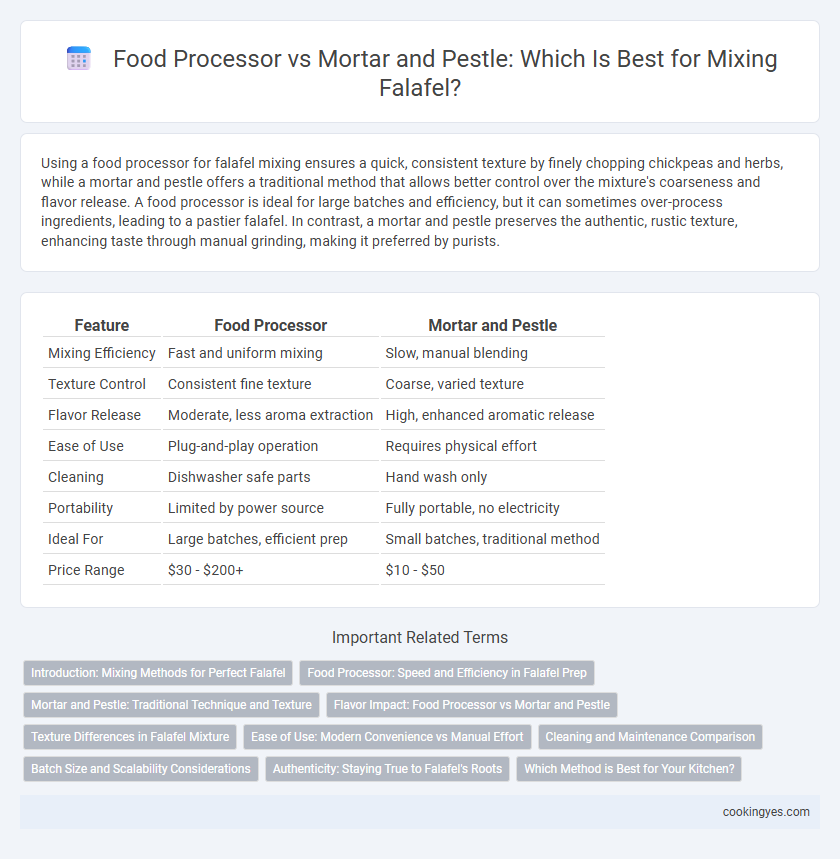Using a food processor for falafel mixing ensures a quick, consistent texture by finely chopping chickpeas and herbs, while a mortar and pestle offers a traditional method that allows better control over the mixture's coarseness and flavor release. A food processor is ideal for large batches and efficiency, but it can sometimes over-process ingredients, leading to a pastier falafel. In contrast, a mortar and pestle preserves the authentic, rustic texture, enhancing taste through manual grinding, making it preferred by purists.
Table of Comparison
| Feature | Food Processor | Mortar and Pestle |
|---|---|---|
| Mixing Efficiency | Fast and uniform mixing | Slow, manual blending |
| Texture Control | Consistent fine texture | Coarse, varied texture |
| Flavor Release | Moderate, less aroma extraction | High, enhanced aromatic release |
| Ease of Use | Plug-and-play operation | Requires physical effort |
| Cleaning | Dishwasher safe parts | Hand wash only |
| Portability | Limited by power source | Fully portable, no electricity |
| Ideal For | Large batches, efficient prep | Small batches, traditional method |
| Price Range | $30 - $200+ | $10 - $50 |
Introduction: Mixing Methods for Perfect Falafel
Using a food processor for falafel mixing ensures a consistent, finely ground texture that helps achieve a uniform blend of chickpeas, herbs, and spices for a smooth, cohesive mixture. In contrast, a mortar and pestle allow for a more controlled, coarse grind that preserves some chunkiness and adds a rustic texture to the falafel. Choosing between these methods impacts the falafel's ultimate texture and taste, with the food processor favored for speed and uniformity, while the mortar and pestle enhance traditional authenticity.
Food Processor: Speed and Efficiency in Falafel Prep
Using a food processor for falafel mixing significantly reduces preparation time by quickly blending chickpeas, herbs, and spices into a uniform mixture. Its powerful blades ensure consistent texture, preventing over-processing that can occur with traditional methods. This efficiency makes the food processor ideal for handling larger batches without sacrificing the quality of the falafel mix.
Mortar and Pestle: Traditional Technique and Texture
Using a mortar and pestle for mixing falafel preserves the traditional texture by gently crushing chickpeas and herbs, resulting in a coarser and more authentic consistency. This manual method enhances the release of essential oils and flavors, producing a richer, more aromatic blend compared to the uniform paste created by food processors. The slower, hands-on technique prevents over-processing, maintaining the ideal grainy texture crucial for perfectly crispy falafel.
Flavor Impact: Food Processor vs Mortar and Pestle
Using a mortar and pestle for mixing falafel ingredients enhances flavor by gently bruising chickpeas and herbs, releasing essential oils and preserving texture for a more authentic taste. In contrast, a food processor quickly blends ingredients but may over-process the mixture, causing a denser texture and slightly muted flavors. Traditional chefs favor mortar and pestle to achieve the ideal fluffy, aromatic falafel with a vibrant herb profile.
Texture Differences in Falafel Mixture
Using a food processor for falafel mixing produces a finer, more uniform texture that ensures quick binding and consistent cooking. In contrast, a mortar and pestle yield a coarser, chunkier falafel mixture with a rustic texture that enhances the final bite's authenticity. Texture differences directly affect falafel's moisture retention and crispiness, making tool choice crucial for desired flavor and mouthfeel.
Ease of Use: Modern Convenience vs Manual Effort
Food processors provide significant ease of use by quickly and evenly blending chickpeas, herbs, and spices for falafel, reducing preparation time and physical effort. Mortar and pestle demand manual labor and skill to achieve the desired coarse texture, offering more control but requiring patience and strength. For home cooks prioritizing convenience and speed, food processors present a modern advantage, while traditionalists may prefer the tactile experience of mortar and pestle blending.
Cleaning and Maintenance Comparison
A food processor offers easier cleaning with detachable, dishwasher-safe parts, reducing time spent on maintenance compared to the mortar and pestle. Mortar and pestle require thorough manual scrubbing to remove sticky falafel mixture residues, often leading to longer drying times and potential for lingering odors. Regular upkeep of food processors involves occasional blade sharpening and motor care, while mortars demand careful handling to avoid chipping and preserve the stone's texture for optimal blending.
Batch Size and Scalability Considerations
Food processors offer efficient falafel mixing for large batch sizes, enabling consistent texture and faster preparation crucial for commercial scalability. Mortar and pestle methods are ideal for small-scale or artisanal batches, providing superior control over ingredient texture but limiting volume capacity and speed. Scalability in falafel production favors food processors due to their ability to handle extensive quantities without compromising quality.
Authenticity: Staying True to Falafel's Roots
Using a mortar and pestle for falafel mixing preserves the traditional texture and flavor by gently grinding chickpeas and herbs, maintaining authenticity rooted in Middle Eastern culinary heritage. Food processors can over-process ingredients, leading to a smoother mixture that may sacrifice the coarse, rustic consistency essential to classic falafel. Embracing the mortar and pestle method ensures genuine taste and cultural fidelity in falafel preparation.
Which Method is Best for Your Kitchen?
Using a food processor for falafel mixing ensures a consistent, smooth texture ideal for quick preparation and larger batches, while a mortar and pestle provides a traditional, coarse grind that enhances flavor depth and authenticity. Choosing between these methods depends on kitchen priorities: efficiency and volume favor the food processor, whereas preserving texture and artisanal quality align with the mortar and pestle. For home cooks seeking balance, a brief pulse in the food processor followed by hand mixing can optimize both texture and taste.
Food Processor vs Mortar and Pestle for falafel mixing Infographic

 cookingyes.com
cookingyes.com